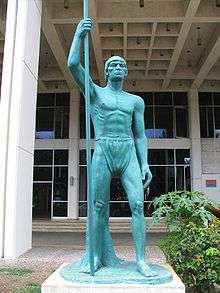Enriquillo
Enriquillo, also known as "Enrique" by the Spaniards, was a Taíno cacique who rebelled against the Spaniards between 1519 and 1533. Enriquillo's rebellion is the best known rebellion of the early Caribbean period. He is also considered a hero in the modern day Dominican Republic and Haiti for his resistance in favor of the indigenous peoples.[1] Dominican friar Bartolome de Las Casas, who documented and rallied against Spanish abuse of the native peoples, wrote sympathetically of Enriquillo.[2]
His father, his aunt Anacaona, and eighty other regional chieftains were killed by Nicolás de Ovando while attending supposed "peace talks" with the Spanish in Jaragua. During the talks, Spanish soldiers ambushed the chieftains, also known as caciques, set the meeting house on fire, and then proceeded to kill anyone who fled the flames (causing his father's death). Enriquillo, an orphan, was later raised in a Santo Domingo monastery and given the name of "Enrico" [3]. One of his mentors was Bartolomé de Las Casas. De Las Casas was a Spanish Roman Catholic Priest focused on the rights of Native Americans. [4]

Life
Good relations between Christopher Columbus and the indigenous Taíno of the large island Columbus called Hispaniola did not last more than a few days. The Taínos were forced into terrible conditions as laborers in gold mining operations, badly housed in the mountains, poorly fed, extremely overworked, and forced to live in close quarters with the Spaniards.[5] Additionally, due to taking men away from the villages, the cycle of food production was disrupted, causing widespread malnutrition.[5] This malnutrition further aided the Taínos' vulnerability to deadly new types of diseases introduced by the foreigners.[5] After Columbus tortured and killed many in his quest for gold, he turned to slavery and sugar cane plantations as a way to profit from his voyages.
Several revolts followed in the first half of the 16th century, the most famous began in 1519. Enriquillo, one of the few remaining caciques, or indigenous chiefs, started the revolt with a large number of Taínos from the mountain range of Bahoruco. The Tainos were able to continue the rebellion because of their better knowledge of the region.[6] As the Spaniards were not able to control the rebellion, a treaty was signed granting to the Native population among others the right of Freedom and of Possession. It had little consequences, however, as by this time the Native population was rapidly declining due to European diseases.
Enriquillo also had a wife, called Mencía, later with the noble title Doña due to Enriquillo's high standing and relations with the Spaniards. She was raped by a Spaniard named Valenzuela. When Enriquillo tried to take the issue to the Spanish courts, nothing could be done, since it was Doña Mencia's word against the Spaniard's word. This, according to some writers, was the tipping point for Enriquillo which led to his revolt in the Bahoruco mountains.
Guarocuya
Most historians agree (see Sued Badillo) that Enriquillo was the same person as the cacique Guarocuya which would mean that Enriquillo belonged to the highest house of the Jaragua cacicazgo. Guarocuya was the nephew of Anacaona, sister to the cacique of Jaragua Bohechío and his eventual successor once Bohechío was killed. Anacaona was married to Caonabo, who was the cacique of the neighboring Maguana kingdom. A minority of historians, however, claim that Guarocuya was captured and hanged, while Enriquillo succeeded in his revolt. Most historians believe both rebels were the same person, arguing that the tales of Guarocuya's demise are identical to the more verifiable accounts of the capture and execution of his aunt Anacaona and the stories have been conflated. It is also well documented that the character of Enriquillo was married to Mencía, the mestiza granddaughter of Anacaona.
His name, Enriquillo, would come after his baptism as a Catholic. The name Enriquillo, "little Enrique," was probably due to his age at the time of the baptism.
Lago Enriquillo
The salt water lake Lago Enriquillo in the Dominican province of Baoruco was named after him. Looking out over it is the Trono de Enriquillo, where he is said to have camped during the rebellion. [7]
In modern culture
The highest rank of the Asociación de Scouts Dominicanos was formerly named after him.
See also
- Hispaniola
- History of the Dominican Republic
- Taíno opposition against the Spanish
- Population history of American indigenous peoples
References
- Ida Altman, "The Revolt of Enriquillo and the Historiography of Early Spanish America," The Americas vol. 63(4)2007, 587-614.
- Bartolome de Las Casas, Historia de las Indias (Mexico, Fondo de Cultura Economico, 1965, second edition, vol. III, p. 260.
- Uriona, Viviana (2009), "Enriquillo and the Taíno revolt (1519–1533)", The International Encyclopedia of Revolution and Protest, American Cancer Society, p. 1, doi:10.1002/9781405198073.wbierp0515, ISBN 9781405198073
- "Bartolomé de Las Casas". www.u-s-history.com. Retrieved 2019-02-27.
- WILSON, Samuel M. (1997). "Surviving European Conquest in the Caribbean". Revista de Arqueología Americana (12): 141–160. ISSN 0188-3631. JSTOR 27768388.
- Altman, Ida (2007-05-10). "The Revolt of Enriquillo and the Historiography of Early Spanish America". The Americas. 63 (4): 587–614. doi:10.1353/tam.2007.0052. ISSN 1533-6247.
- "Lago Enriquillo and Isla Cabritos - Dominican Republic Lake". mydominicanvacation.com. Retrieved 2019-02-27.
Further reading
- Altman, Ida, "The Revolt of Enriquillo and the Historiography of Early Spanish America," The Americas vol. 63(4)2007, 587-614.
- Sued Badillo, Jalil. General History of the Caribbean Volume I: Autochthonous Societies (English, Macmillan Caribbean, 2002)
- Van Der Helm, Rien. Reis-handboek Dominicaanse Republiek (Dutch language, Elmar, 1991)
External links